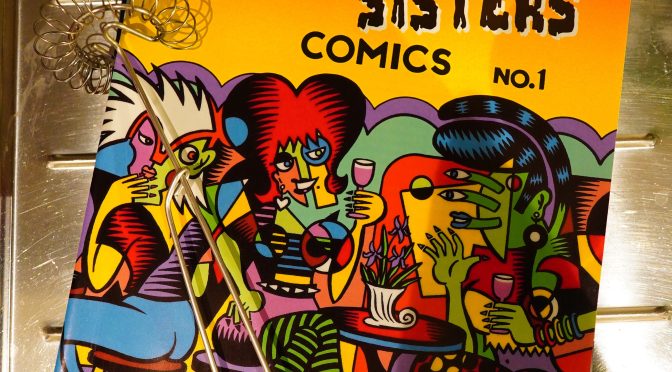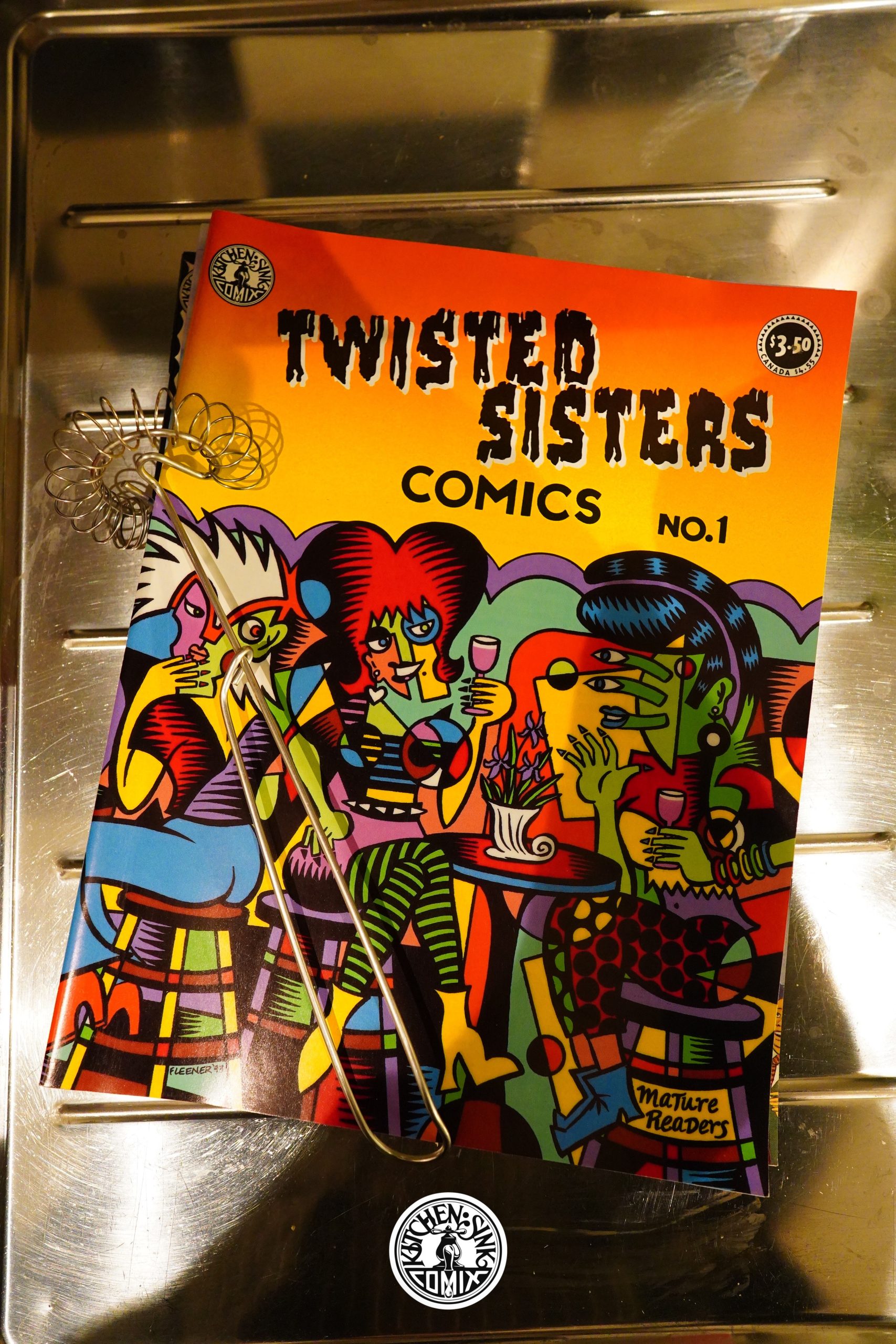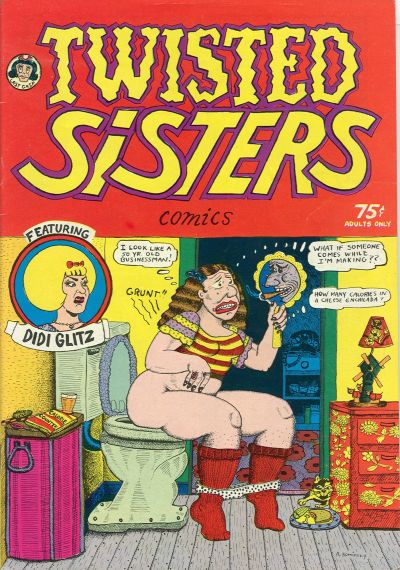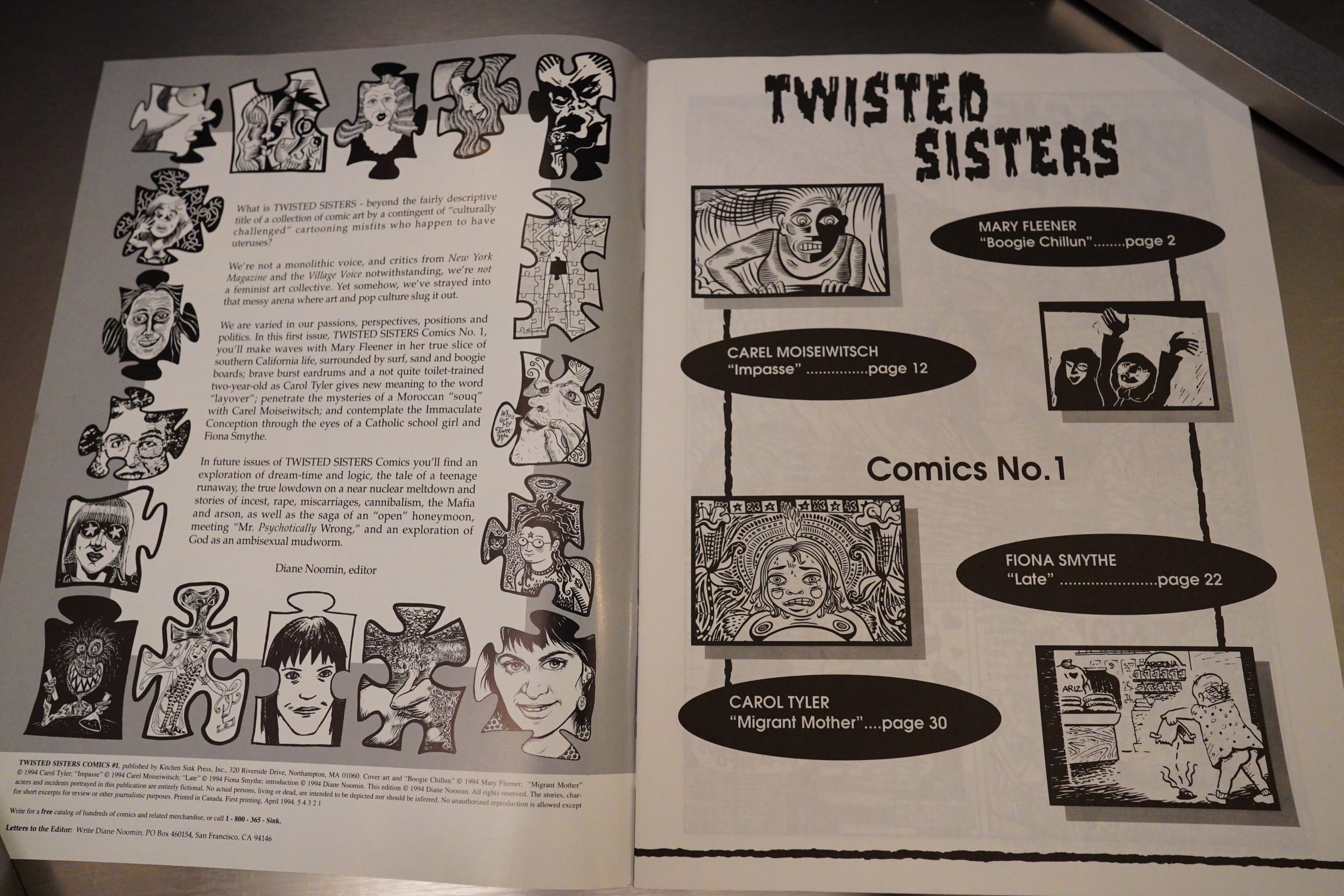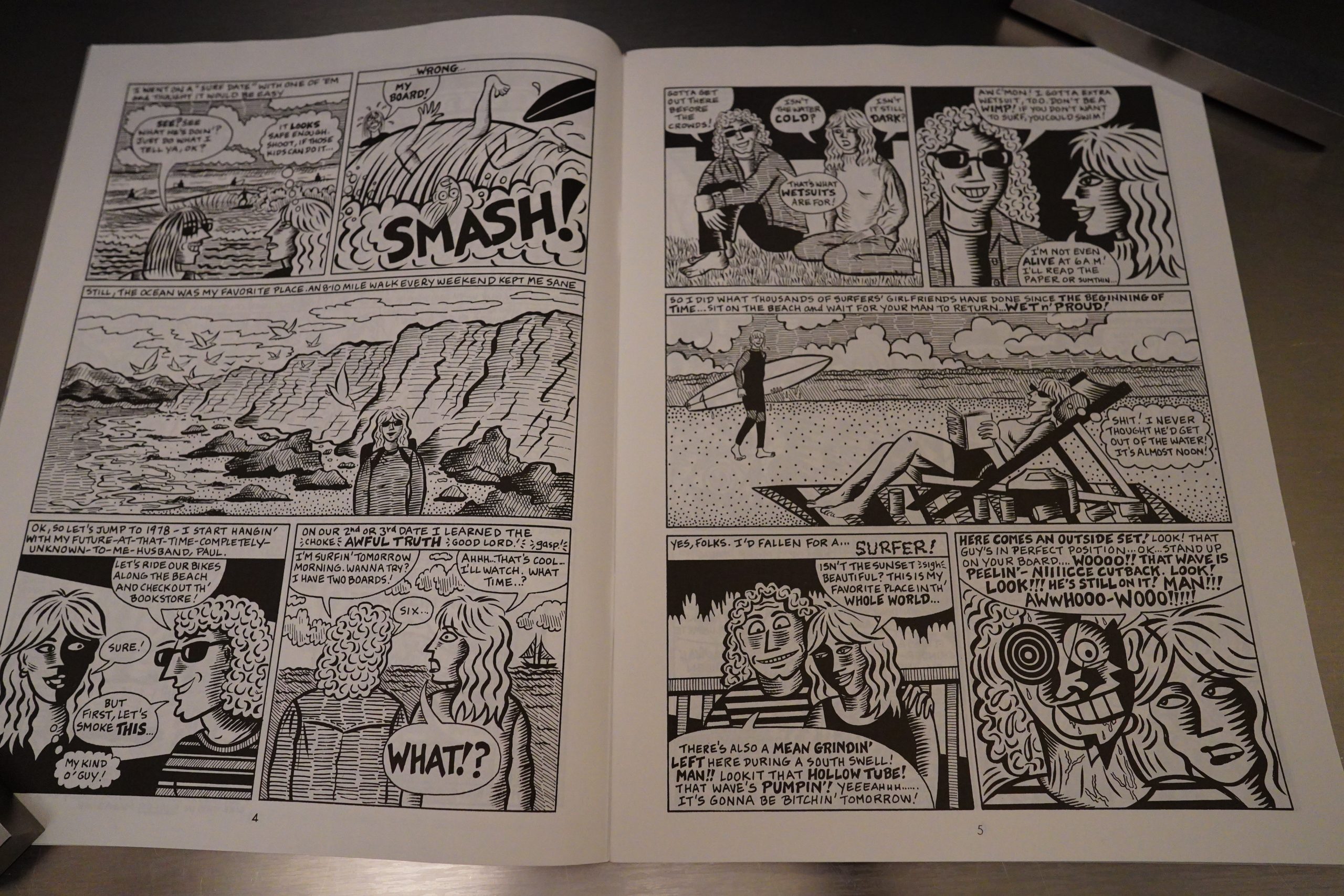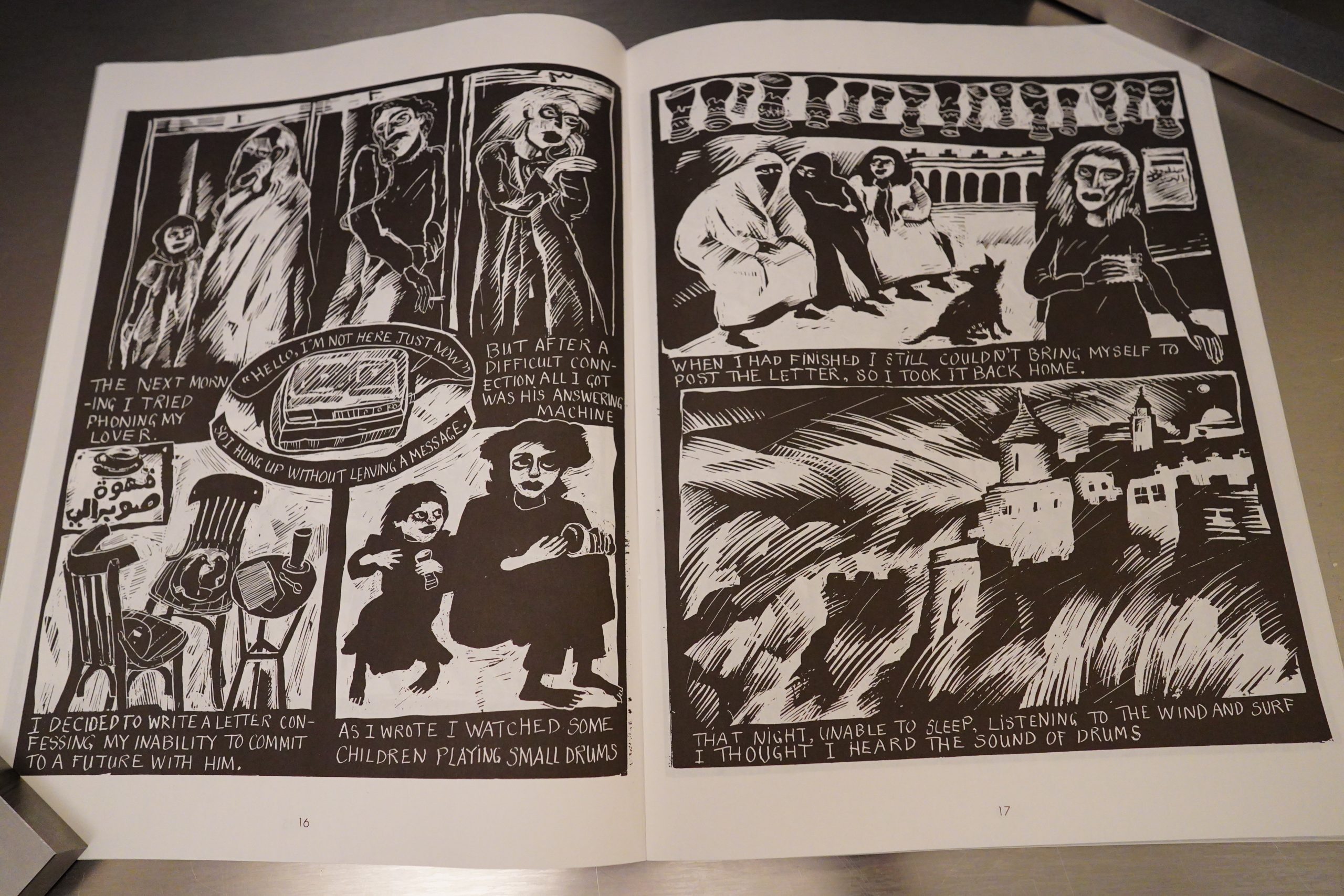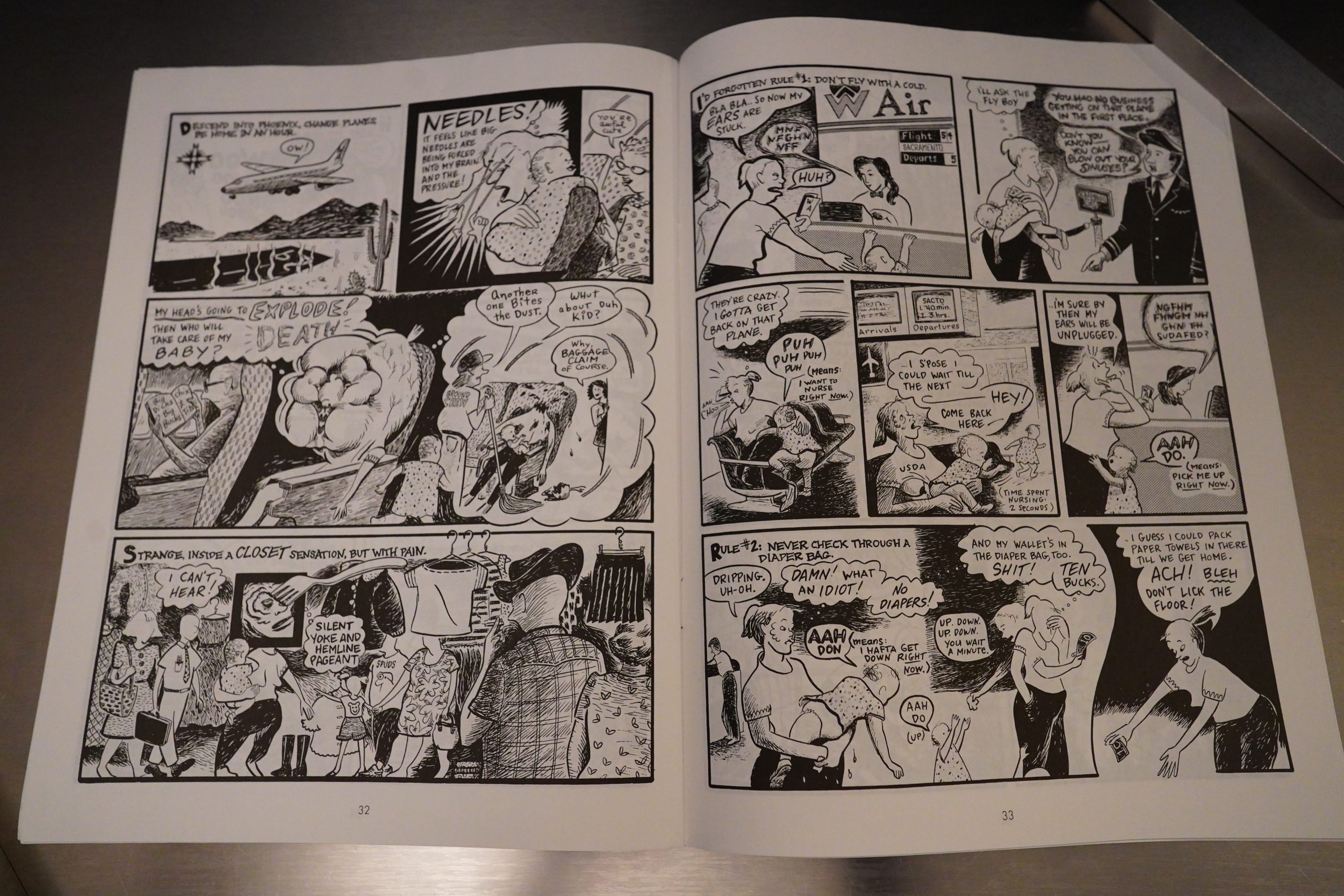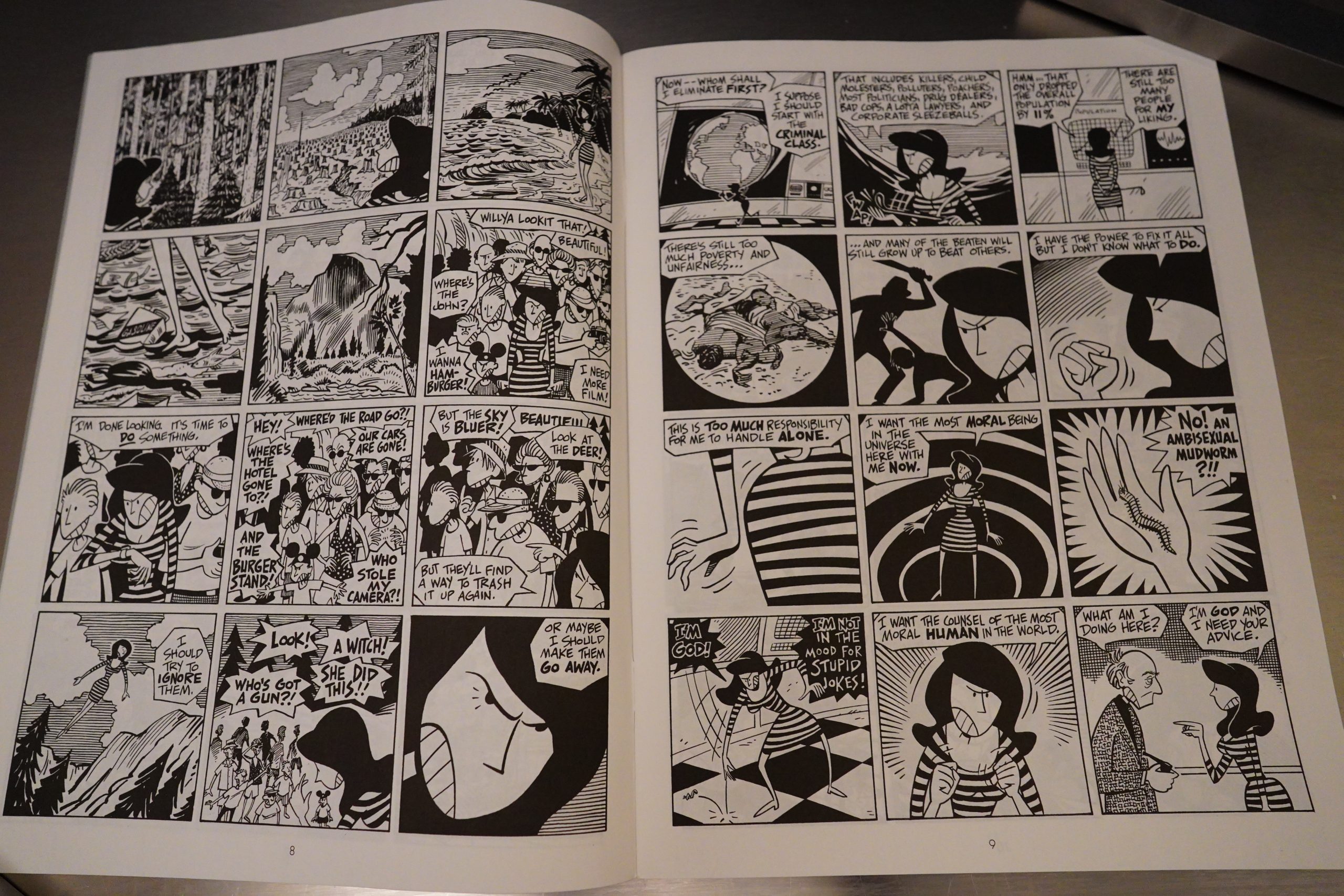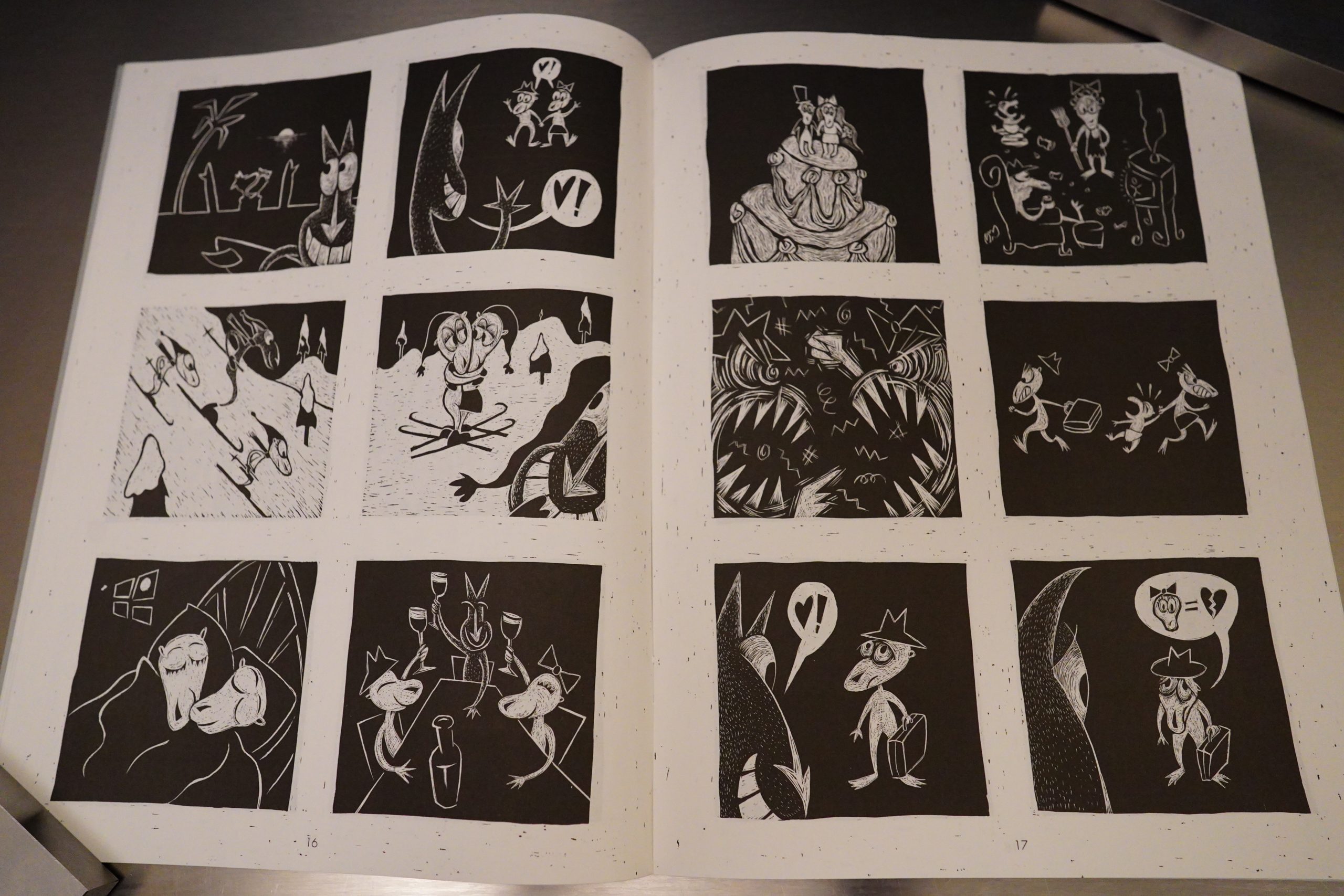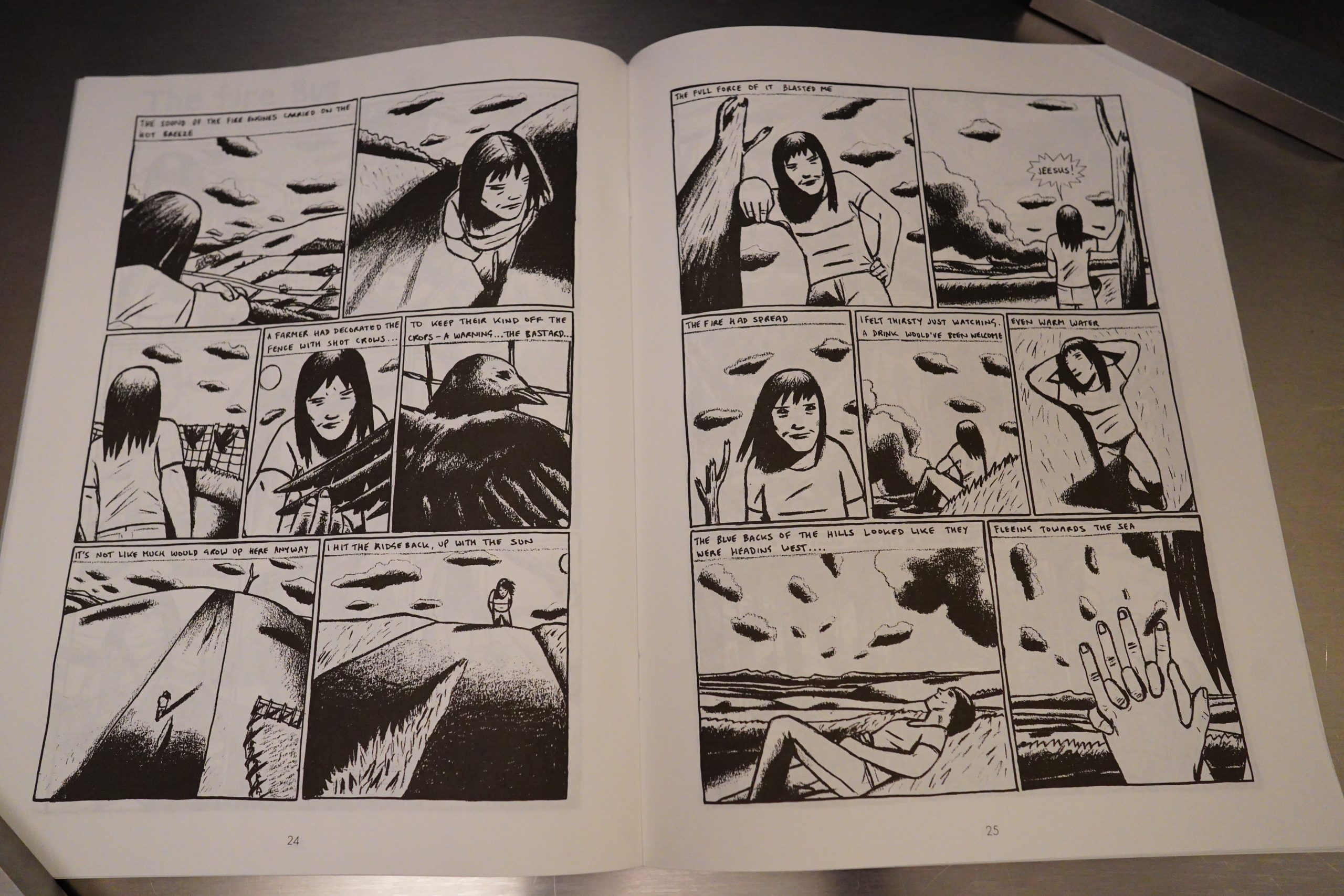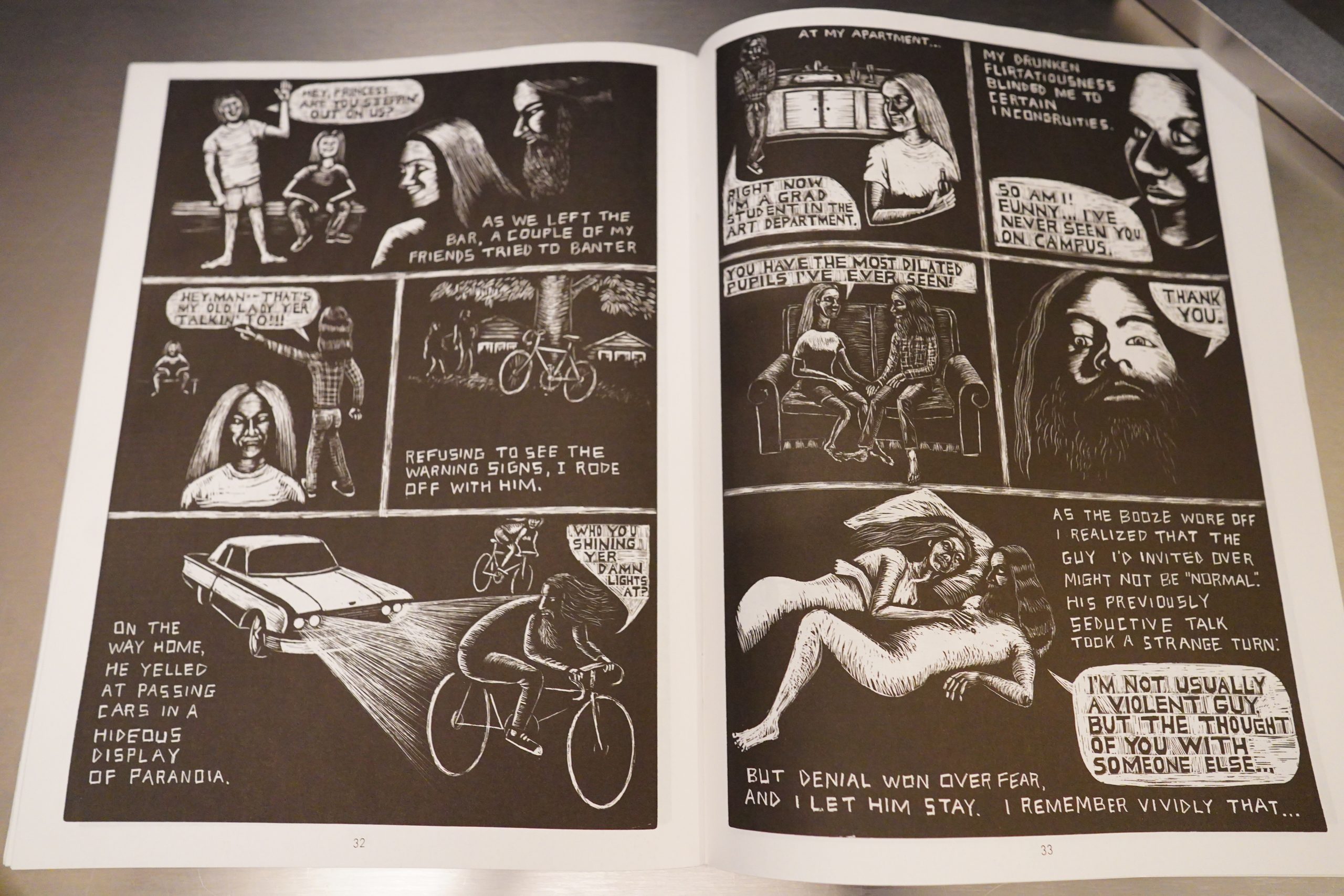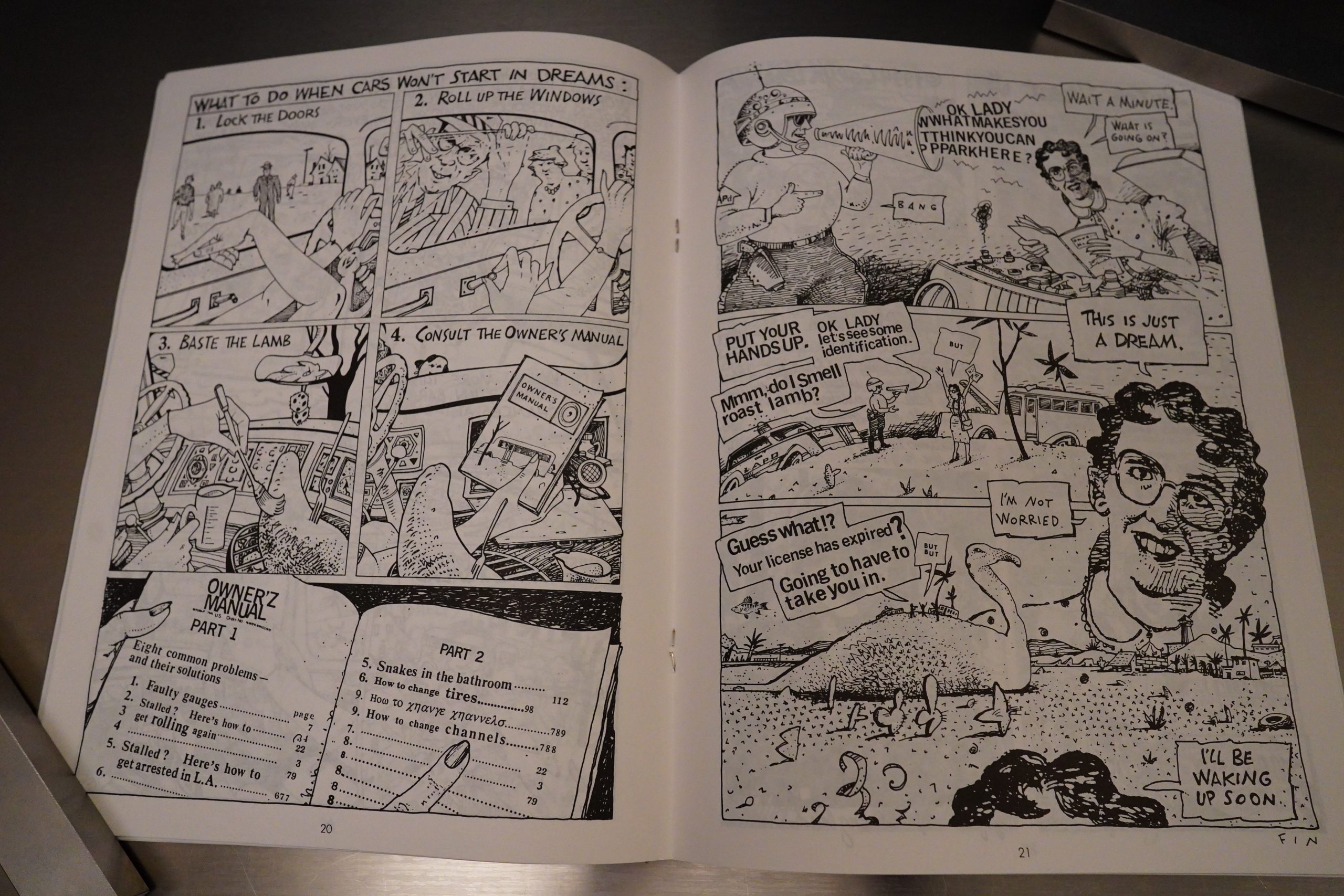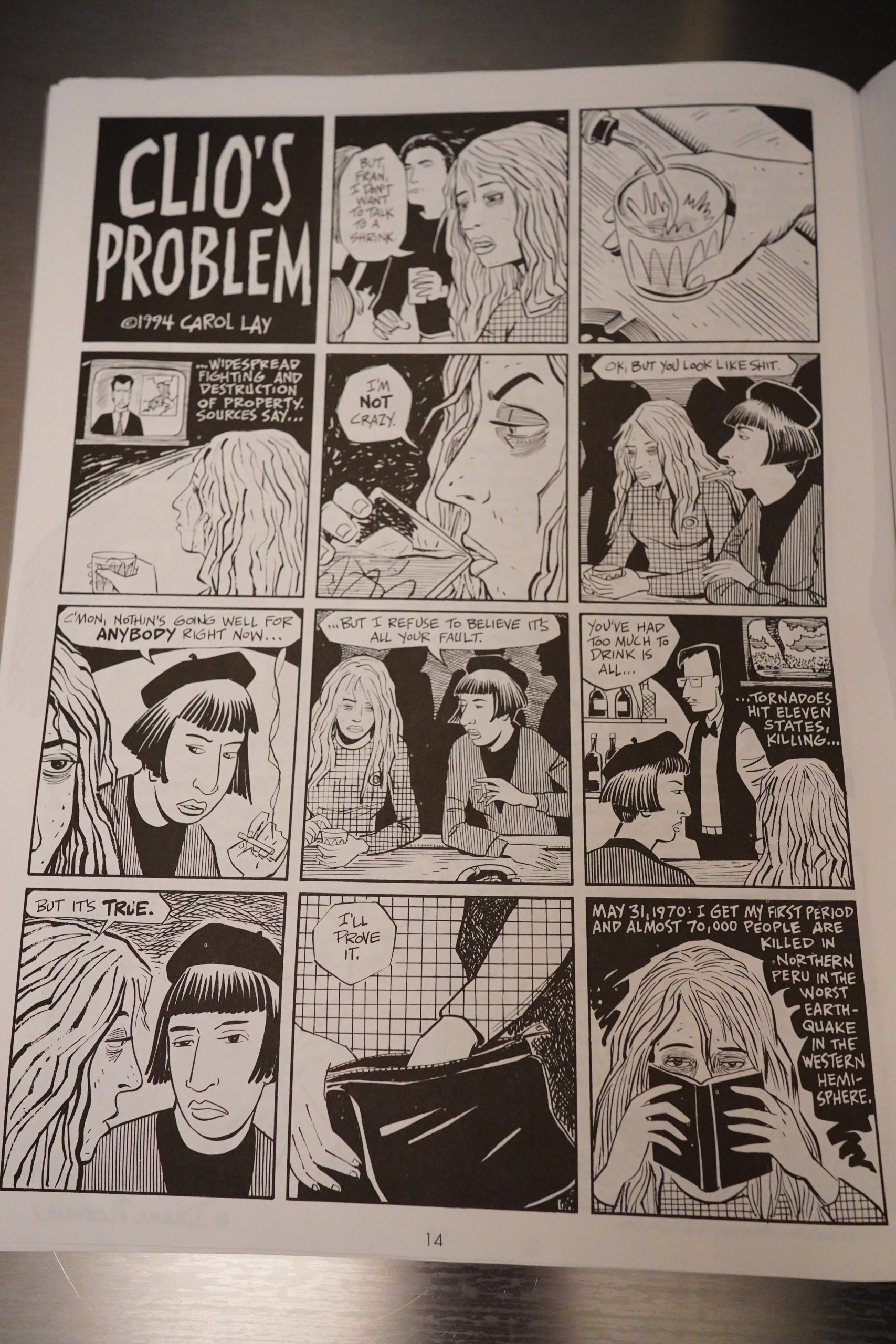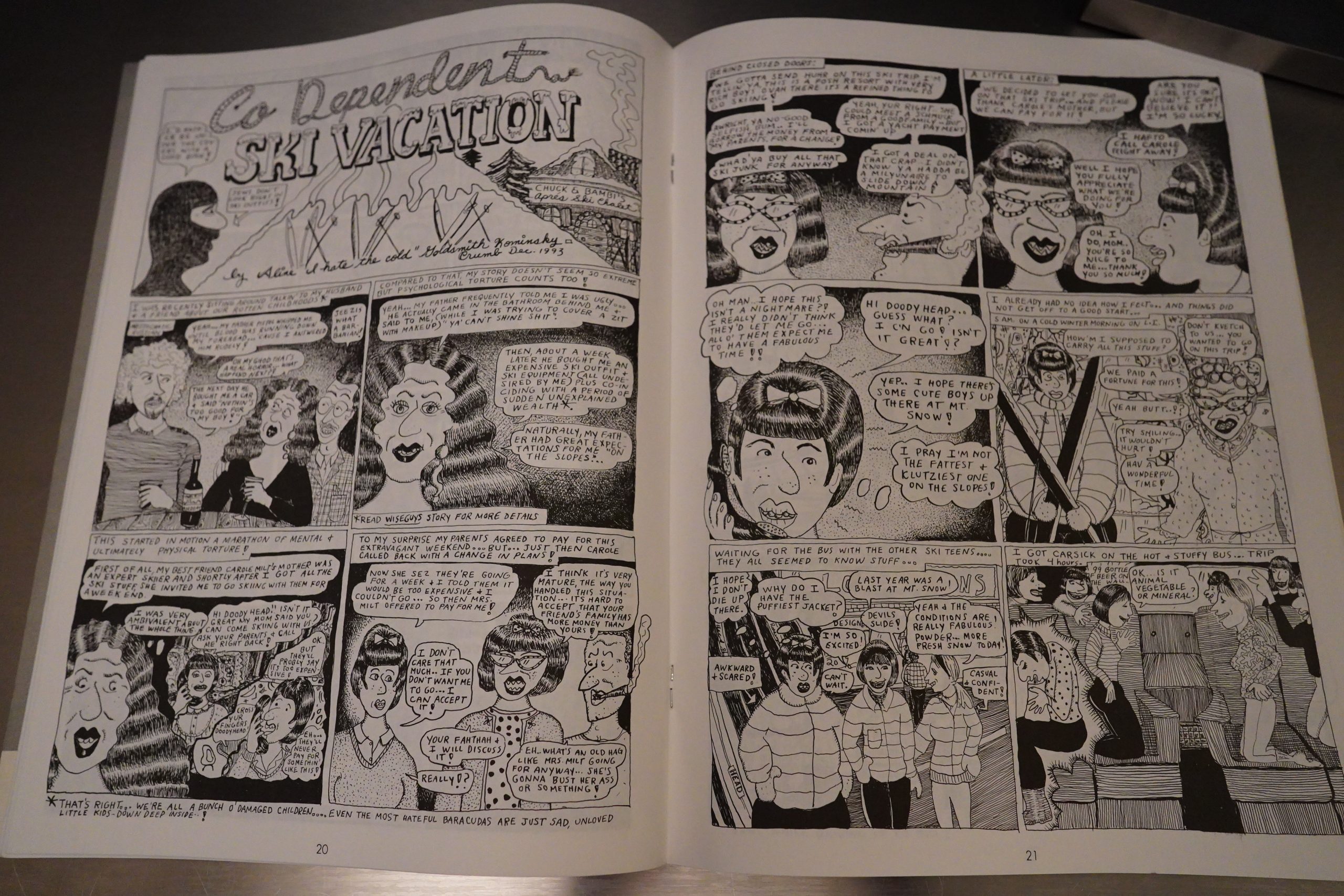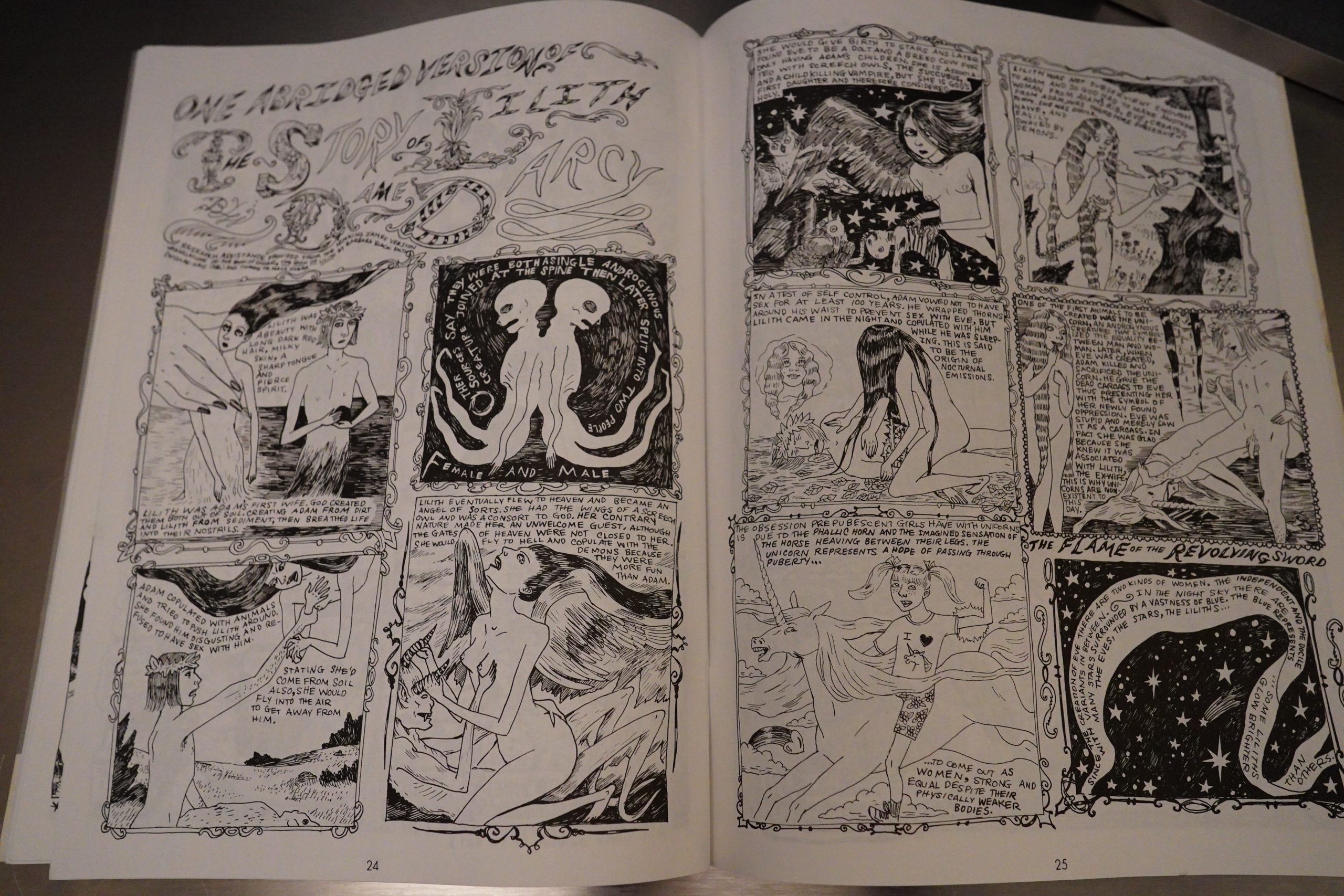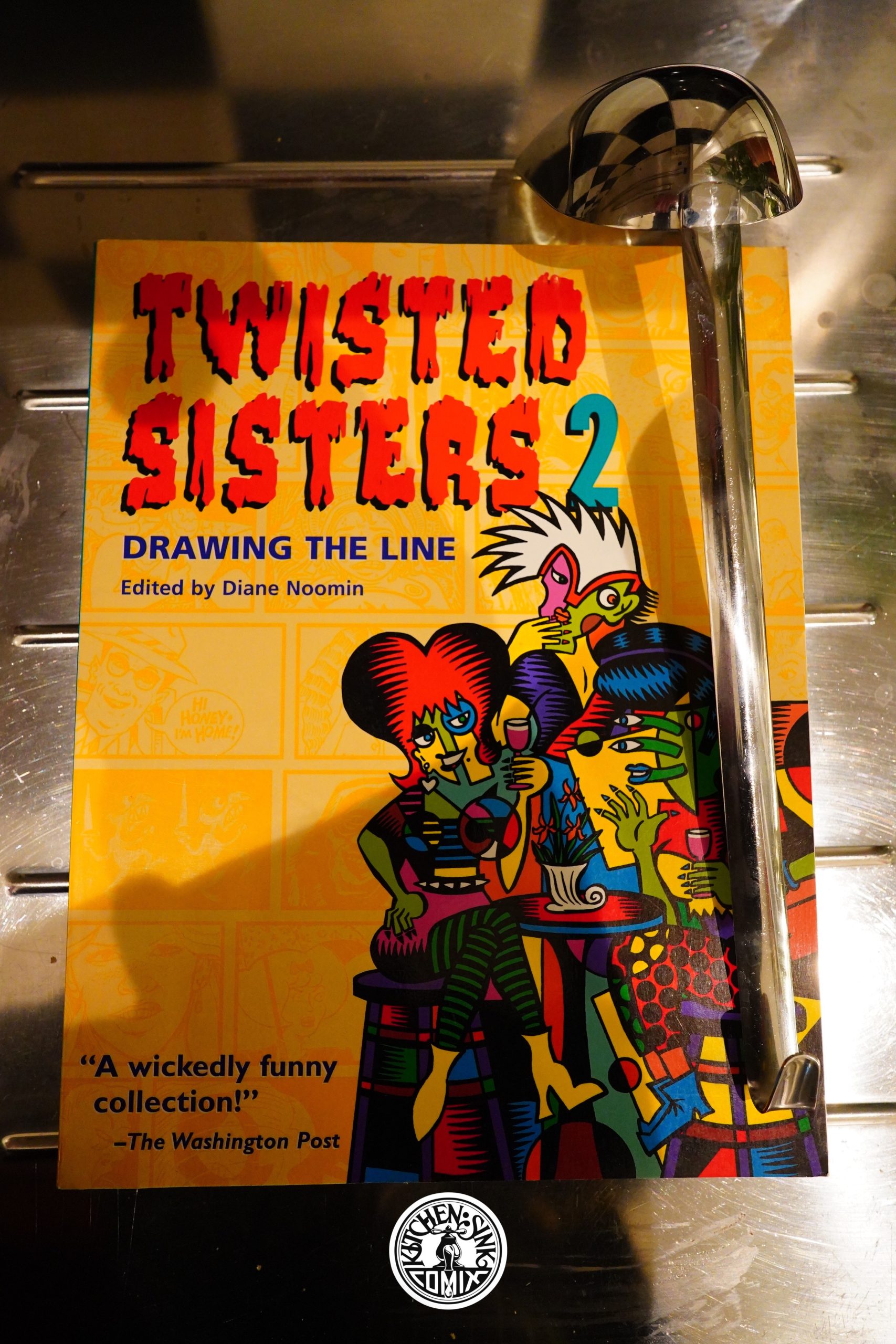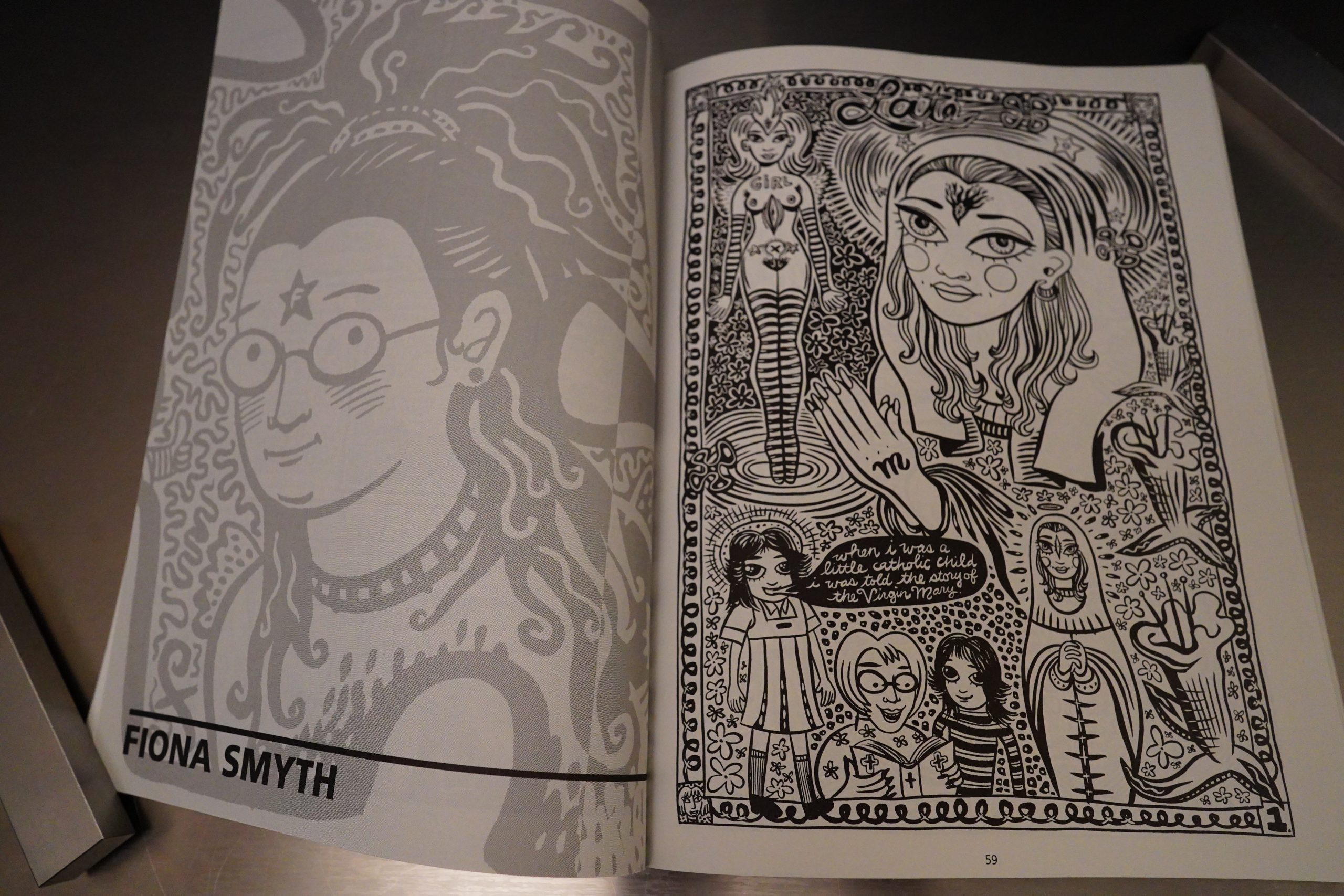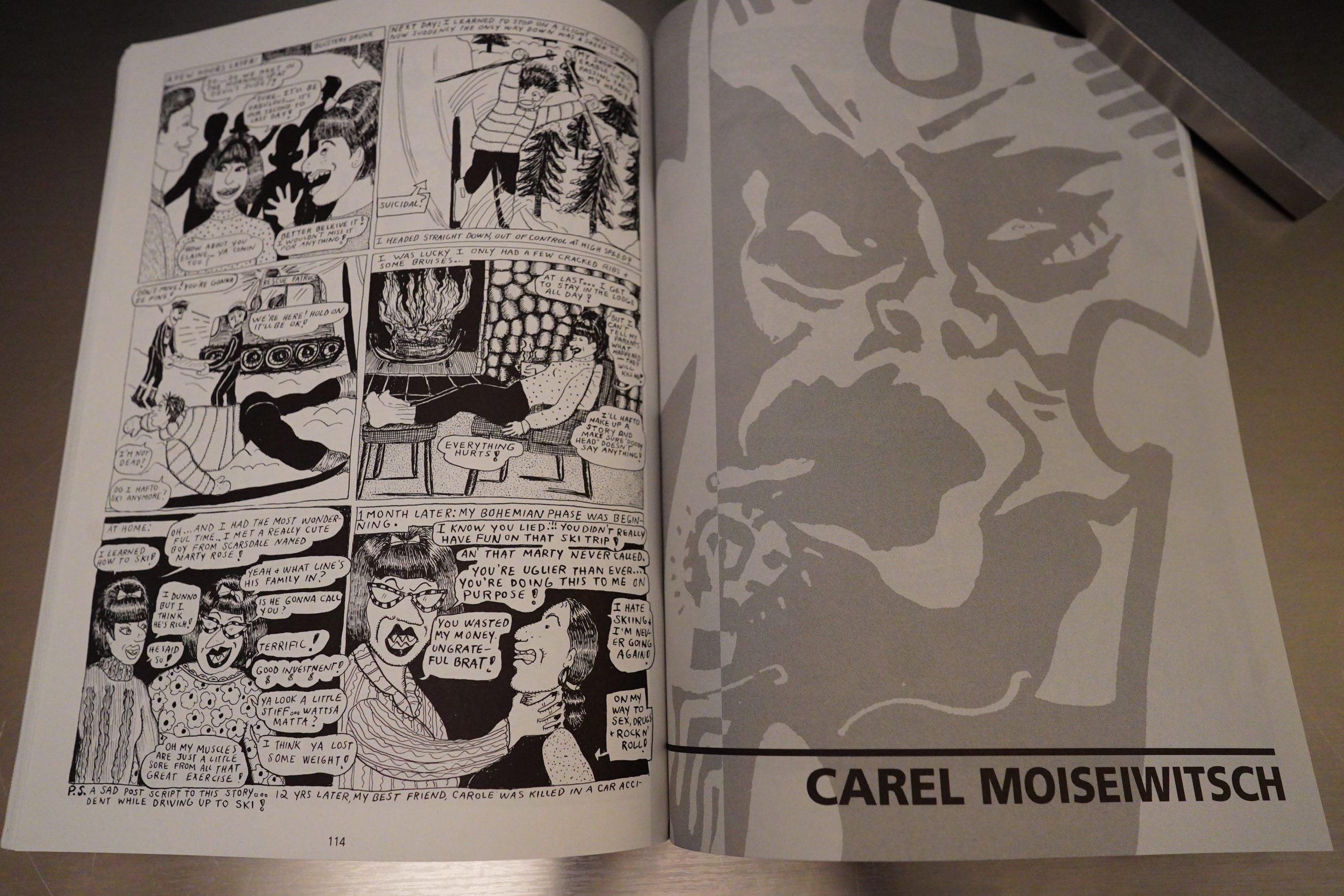Twisted Sisters (1994) #1-4,
Twisted Sisters, Volume 2: Drawing the Line (1995) edited by Diane Noomin
In the mid-70s, the original Twisted Sisters (featuring Noomin and Aline Kominsky) had been published by Last Gasp.
In 1991, Noomin revived the name and published a collection at Penguin. I didn’t buy it at the time, because it basically just reprints a whole bunch of stuff from Weirdo, Drawn & Quarterly and other places, and I already had all of that stuff. Looking at the contents now, it seems like it’s mostly shorter pieces — two to five pages — but the contributors are pretty much the same as in this later Kitchen Sink series.
I’m not surprised that Penguin published that book in 1991 — many of the major book publishers were dipping their toes into the comics waters after the success of Maus — but quickly withdrew after it turned out that the only book that sold in bookstores was, well, Maus. And Maus II.
So I wonder about the origins of this four issue magazine series (and book that follows): There are no reprints here, and it’s virtually only ten page stories. So after making the first book (which had to be really cheap to make, being all reprints), did Noomin reach out to the people featured, flush with Penguin money for advances, and ask for ten page stories specially for this series?
If so, it’s somewhat unusual — anthologies are notorious money-losers, so few editors have enough money to do that, and instead wait for people to send in whatever they have. But Penguin surely has money… and perhaps Kevin Eastman (who subsidised Kitchen Sink with $2M over 93-94) had money.
The four Twisted Sisters issues are arranged kinda-sorta thematically. The first issue is mostly about relationships, like this Mary Fleener piece about surfers. (I adore that look on that guy’s face in the final panel there.)
Carel Moiseiwitsch goes more harrowing, as usual, with a break-up story of sorts. Man, that’s wonderful artwork…
I can’t get over how much this book has its finger on the pulse of what was exciting around this time. I had expected more oldey-tymey underground artists, but the vast majority of people here are young artists, like Fiona Smyth, or people who had recently started doing comics.
But I shouldn’t be surprised: Noomin previously edited probably the best underground anthology ever. She had impeccable taste in comics. (She died last September.)
Carol Tyler finishes out the issue with a harrowing tale of being stuck in an airport without much money. Fantastic.
The second issue seems to focus more on distinctive looking stylists, with Carol Lay starting things off with a story about being god.
Krystine Kryttre does a wordless strip about relationships and stuff. Unfortunately, it doesn’t really end up being more than a well-worn joke in the end.
Carol Swain’s piece is wonderful, though. Lyrical and unnerving.
Penny Van Horn finishes out the issue with a scratchboard (like Kryttre) piece, but unlike Kryttre, it’s not silent.
(Oops. Out of focus… I forgot to change the settings on the camera back to “manual”…)
The third issue is a harrowing one, and is the only very explicit one, I guess? Debbie Dreschler does a strip about being sixteen, and she gets raped.
Look at that obsessive patterning — it’s amazing.
So as a breather after that, we get an absurd dreamy piece by MK Brown…
… before being thrown back into pure nightmare as we get Minnie’s 3rd Love by Phoebe Gloeckner, which shows up in anthologies here and there, I think. It’s all the more horrific for being as straightforward as it is. (I’m not snapping any of the harsher pages here, because this is a family oriented blog, you know.)
The final issue is quite different from the first three. It’s mainly older artists, and they’re a lot chattier than the younger ones. There’s probably as many words in this issue as in the first three put together. Diane Noomin herself starts the party with a story about miscarriages.
And there’s shorter pieces here, and Carol Lay shows up again.
Aline Kominsky-Crumb has two stories here, one shorter about going skiing…
… and one longer, even chattier one about the rumours about her father having mob connections. It’s fun.
But there’s also younger people here, like Dame Darcy. (But again, very wordy.)
And finally, Leslie Sternbergh — a three pager about Three Mile Island, that… er… feels slightly out of place.
This was all collected next year in a book.
It has exactly the same material, but we get these author portrait pages (possibly crabbed from the strips themselves).
Caryn Leschen is the only name from the anthology that doesn’t seem familiar to me.
Heh nice.
Anyway — fantastic anthology. Many really strong pieces. A couple of the pieces feel like they’re less inspired — as if they didn’t really have an idea for a strip but coughed one up anyway — but the vast majority are excellent.
The Comics Journal #167, page 28:
Twisted Sisters Comics Collects
All-New Work by WomenIn the year 1976, Diane Noomin (creator of
comics featuring Dil)i Glitz) and Aline Komin-
sky (author of Love that Bunch) published a
comic Of their own called Twisted Sisters. In
April of 1994, the
third publication to
go by that name
(Penguin released
the second, a Noomin-
edited T,visted Sisters
anthology of women
cartoonists, in 1991)
will ship to comic
shops — Twisted
Sisters Comics #1 —
beginning a limited
series Of four comics
which will collect
the all-new work
of not just two, but 17 prominent women
cartoonists.
Edited by Noomin and published by
Kitchen Sink Press (KSP), Twisted Sisters
Comics will first appear as four monthly, 40-
page, magazine-sized, black-and-white comics
(sold at $3.50 a pop).
The first issue is wrapped in a vibrant color
cover by Mary Fleener, the creator of Slut-
burger for Drawn & Quarterly, who is known
for her brilliant cubist graphics. Fleener also
contributes a story to the issue, “Boogie
Chillun’ ,” which Noomin describes as ‘ ‘a slice
of Southern California life with surf, sand,
boogie boards,” and lots Of wave action.”[…]
Noomin told the Journal that she selected
the contributors based on her own taste and de-
sire for stories “personal and
deeply felt. There is a large
chunk of autobiography.
Some of it is more intense
than others, some Of it is more
removed.” Each story in these
magazines was created spe-
cifically for Twisted Sisters
Comics — as opposed to the
Penguin Twisted Sisters an-
thology (which KSP has
signed on to reprint in the near
future), for which Noomin se-
lected previously existing
work. Her intent in soliciting
new work was to “have everybody do a long
Story… giving people room to expand.”
When asked if the advantages of women
publishing together outweigh the disadvan-
tages of segregation by sex, Noomin re-
sponded: “All of these women have the
opportunity to be in other books, so it’s not like
this is the only way they will be thought of.
These are all very well-known, prominent car-
toonists who have been in anthology collec-
tions of men and women. I would be happy if it
weren’t necessary to do this, but I think that it
is important, because seeing strong line-ups of
women cartoonists together makes people
aware that there are a lot of.strong women car-
toonists out there.
Noomin is interviewed in The Comics Journal #162, page 74:
PINKHAM: How didyoufirstconceive ofTwisted S isters, the
anthology ?
NOOMIN: Originally, Aline and I wanted to edit it together.
We’d thought off and on for years about doing Twisted
Sisters as a book, but we were going to do it with just the
two of us. Then Aline, having been the editor of Weirdo,
became aware of a lot of really talented women cartoon-
ists. We decided we’d like to include other people in the
book. We started making a list and looking at women we
wanted to include and writing to them. But after, I think,
the first letter — this was way before we had a publisher
or before the book had any reality other than just talking
about it and seeing if people were interested — Aline
decided to move to France. So I decided to do it on my own.
I really thought it was a good project and I’d gotten very
positive responses from the women we had written to. So,
since it was an anthology of previously printed work, I
made up a bunch of dummies and went to New York and
knocked on publishers’ doors. I was very fortunate to meet
David Stanford at Penguin; he’s an editor who’s knbwl-
edgeable about comics, as well as being a sympathetic,
nice guy. I mean, I had people at Grove Press telling me
that Twisted Sisters was too underground. That was kind
of interesting to me — the publishers of Henry Miller
thought it was too sexual.
PINKHAM: There ‘s a double standard for you.
NOOMIN: Yeah, I saw probably a dozen publishers. Penguin
was the one I wanted the most, and when they wanted to
do it I was very happy.
PMHAM: Why Penguin ?
NOOMIN: Well, they were doing RA W, and they had done
some other comic anthologies. They were a very reputable
firm with great distribution, and they were international.
To me it was an incredible leap out ofthe underground, so
I was very excited. I’m still grateful to David for taking a
chance on the material, but I was very unhappy , ultimately ,
with the way… I read in The New York Times that “Pen-
guin was in disarray” — that’s a direct quote. As a result
Of that, there were a lot of screw-ups and they didn’ t quite
know what they had.
It’ s very hard for me to say this without it soundi ng like
sour grapes, but I’m going to say it anyway: I think that
Twisted Sisters had the potential to be a breakthrough
book. It got really, really good reviews and good response,
and it sold out its print run in eight months. But Penguin
was in such disarray that they didn ‘ t know or acknowledge
that it had sold out its print run, and it took them another
four or fi ve months to figure that Out. By that ti me, they had
a new chief editor in charge of all trade paperbacks who
had decided as a policy that they weren’t going to do any
more comic anthologies. So I guess it didn ‘ t make sense to
them to reprint, although I’m convinced that if they had
reprinted at the time, they would have sold out another
print run.
So I was kind of grateful to them and really thrilled that
we wound up in the shopping malls and got reviewed and
became very visible, and on the other hand, I felt that itjust
kind of died on the vine and I was very frustrated. So I have
mixed feelings about it. I think that probably with any big
publisher, that’ s the way they operate— they let a book go
and if it sells really, really well, maybe they’ll put money
into it, maybe tlry won’t. In this case it was a double-
whammy because they didn ‘t realize it had done well until
it was sort of too late. There were back orders at the
distributors and I got people calling me saying they can’t
find the book anywhere, and I got comic book stores here
telling me it was selling great, can’t they get another 200
Copies, and Last Gasp — who [also] distributed it — kept
calling me and saying, ‘Can’ t we get copies? What’ s going
on?’ So I was very frustrated, to put it mildly, Luckily, I
had retained foreign rights, so there’s also a German
version published by Elefantin Press.
Now what’s happening is I’ve been working on Twisted
Sisters 2, with most of the same cartoonists, adding a few
and dropping a few from the first one. The arti sts have been
working on long stories On trust, believing that I would
find another publisher. Twisted Sisters has created a real
strong feeling of identity among the women that are in it.
They’re very proud of it, and I’m very proud of it. That’s
really nice, that’s rewarding. But it’s taken me much
longerthan I thought. So now what is happening is Kitchen
Sinknundra — what are they calling themselves?
PINKHAM: Right now both companies apparently exist.
NOOMIN: Well, anyway, they’re doing the new Twisted
Sisters, and they’re going to reprint the first anthology, So
I’m very excited about that. The first book will be back in
print this spring, and the new one should come out in the
fall of ’94. I,have a long story that I’m doing, I have to
design the book, design the cover, and get it all ready to
hand in pretty fast. So I have a lot of work right now. But
I like having the deadlines; it really helps. And I’m very
excited about Twisted 2, because it’s going to be all new
work and all long stories — most of the stories are going
to be about ten pages. It’s going to be a real rich book.
PINKHAM: Is it going to be roughly the same size as the last
Twisted Sisters?
N00MIN;Neah. It’ll be the same size, but it won’t be as
thick. It will be about 160 pages.
PINKHAM: What’s its title, exacily?
NOOWN: It’ II still be Twisted Sisters, butl have to come up
with a new subtitle. have hundreds. I haven’t settled on
one yet. [laughs] Denis has banded together with other
independent publishers to hire regional reps to go to
bookstores. So L think that even though Kitchen Sink is
smaller — it’ s not Penguin — on the other hand they ‘ 11 be
pushing it more, and it hopefully will get into bookstores
as well as comic book stores.
PI*HAM: It should be more important to them than to
Penguin.
NOOMIN: Yeah. So it has advantages. Plus I have editorial
freedom. I had been talking to some big New York
publishers and they wanted me to change the title.
PINKHAM: What was the reason given for that ?
NOOMIN: never quite got it. Their reason was “sequels
don’t sell well.” I think the basic reason was since it was
a new publisher, they wanted it to be their book and noi
Penguin’s book, so they wanted a new title. That’s how I
have the hundreds of subtitles — I was trying to come up
with new titles because I was seriously considering it. But
I was never happy about doing that. They also wanted to
shrink it down to a smaller format. They wanted other
‘hooks,” and to me the work really stands on its own. It
doesn’t need a hook to exist. So I get that kind of freedom
and editorial control with Kitchen and I’m very happy
about it.
PINKHAM: Along the way, before the first book was re-
leased, what sort Of support did you get from Penguin?
Were they actively interested in how Twisted Sisters was
proceeding ?
NOOMIN: They assigned a publicist to it and she did the sort
ofthings that they do. But there were so many screw-ups..
there were a lot of people that didn’t get books. I got this
great quote from Madonna, then I got a call from her
publicist saying she never got her complimentary copy.
Pretty embarrassing.
Penguin did do some things that I really appreciated in
the beginning. They have a printer in the Bible belt —
PINKHAM: Not the Bagel belt.
NOOMIN: [laughs] No, the Bible belt. And they refused to
print the book. They had made the negs, I think, and the
strippers or the on-line pressmen were deeply offended at
the content… I’d love to know exactly what got them so
upset. This istheplacethatprints Newsweek; it’s Penguin’s
major printer, and they risked Penguin getting angry at
them. They were so disgusted they refused to print the
book. So [Penguin] had to scramble to find another printer,
and I Was concerned that maybe they would decide: “Wait
a minute… This is an indication that maybe we shouldn’t
do the book.” But Penguin was really good about that.
They put out a press release and•they upped the print run,
as a result of that. So they did some very good things and,
like I said, I’m really grateful to them for doing this sortof
controversial book. But I felt very frustrated with the
minutiae of getting it out into the world. Hopefully we’ll
have better luck this time.
Ah, so I guessed wrong, and there were no fat advance cheques being written by anybody. But I guessed right in that the pieces were made especially for this anthology.
And Kitchen Sink was supposed to reprint the first anthology, but that never happened, unfortunately. The first anthology sold out and now fetches pretty steep prices on Amazon.
The Comics Journal #184, page 46:
Customs objections to Twisted Sisters II
centered on the story “Minnie’s True Love,”
by Phoebe Gloeckner. The tale depicts the
experiences of a teenage runaway who be-
came a prostitute and drug addict, in admit-
tedly explicit but unerotic images and lan-
guage.
Lawyers for Knockabout argued before
the three magistrate panel that the works
were neither pornographic nor obscene, and
that the comics were widely regarded as
works of art. To support their argument the
defense called as their first expert witness
Paul Gravett, administrator of the Cartoon
Art Trust. The trust is an educational and ar-
chival charity whose patron is the Duke of
Edinburgh. Gravett told the court Crumb’s
work is in the same tradition as British artists
Hogarth and Rowlandson. Gravett went on to
describe Crumb as one of the most important
cartoonists of the last 25 years, placing him
in the historical context of art produced by
underground comics artists.Gravett told the
court that both the Crumb and Gloeckner art-
work in question served the function of hold-
ing a mirror to the affectations and evils of
modern society.
Next up for the defense was Dr. William
Thompson, a professor of criminology from
Reading University. An expert in obscenity
laws, Thompson defended My Trouble With
Women against the charges, telling the
Uxbridge Magistrates Court that he uses
Crumb’s work in his own lectures. “Thomp-
son was very passionate, and was able to lead
the magistrates through Twisted Sisters, and
his testimony really impressed them,”
Bennett told the Journal. Thompson’s testi-
mony claimed that both the main items
served a purpose that was anti-erotic by forc-
ing the reader to focus on the interpersonal
relationships and emotions of the characters,
however dysfunctional. Such a focus, the
professor testified, is the antithesis of por-
nography, where the intent is to titillate and
arouse.
The Comics Journal #169, page 120:
•lie Penguin paperback collection Bvisted Sisters, a
landmark of the new generation of female cartoon-
ists, has finally been followed by its much-antici-
pated regular anthology title, Twisted Sisters
Comics, and it does not disappoint. Editor Diane
Noornin has chosen wisely, and all eight of the su»
ries (each one between eight and 12 pages long) in
the first two issues are brilliant. Issue #1 features
Mary Fleener (“Boogie Chillum” the Story Of how
she fell in love with surfing), Carel Moiseiwitsch
(“Impasse,” a personal allegory Of culture shock),
Fiona Smythe (“Late,” a giddy rendering of the mix-
ture of Catholic doctrine and menstruation), and
Carol Tyler (“Migrant Mother,” an excruciating tale
of the horrors of rncxlern air travel with children). ls-
sue #2 features Carol Lay for a Day,” a mas-
terpiece of comic speculation and wish fulfillment),
Krystine Kryttre (“Friend,” a wordless poem on the
dangers of relationships)/ Carol Swain (“The Fire-
bug,” a spare, evocative story of place), and Penny
Moran Van Horn (“Psycho Drifter,” exactly what it
sounds like). At $3.50 for 40 quality pages, maga-
Carol Lay is interviwed in The Comics Journal #213, page 68:
WORCESTER: Where does Twisted Sisters fit in to this?
LAY: Well, Diane Newman and Aline Kaminsky got
together and wanted to do feminist — well, not really
feminist comics — but comics by women that were
sort of bad girl stuff. Talking about issues that would
be considered politically incorrect for Wtmmen ‘s Comix
or any of the other girl rags. They got together a good
collection Of female artists for that. In a way, I don’t
like being in all-women books, because ids sort of
segregating women from men, as if we have some
handicap or something. You know, you can’t read an
article in the [New York] Times about some woman
scientist without them making a real big deal about
how she wears her hair and the factthat there are so few
women scientists. We won’t have a truly equal society
until thaes not even mentioned. so in a way, putting
out a book Of all women stuff is anti-feminist. In
another way, ids good to get that material out there for
an audience of women. a handy way to get a real
dose of it. They pulled together some great stuff, and
it got a lot Of good media attention. I think Aline and
Diane did really great stories, especially for the second
one, and Carol Tyler… I like her work a lot. Fleener
and Kryttre did cool stuff, as well as Phoebe Gloekner
and a few others. There was some work didn’t blow my
skirt up… My stuff was really different from most of
the stories in Twisted Sisters in that mine were stories
rather than autobiographical pieces.
This is the one hundred and sixty-seventh post in the Entire Kitchen Sink blog series.
